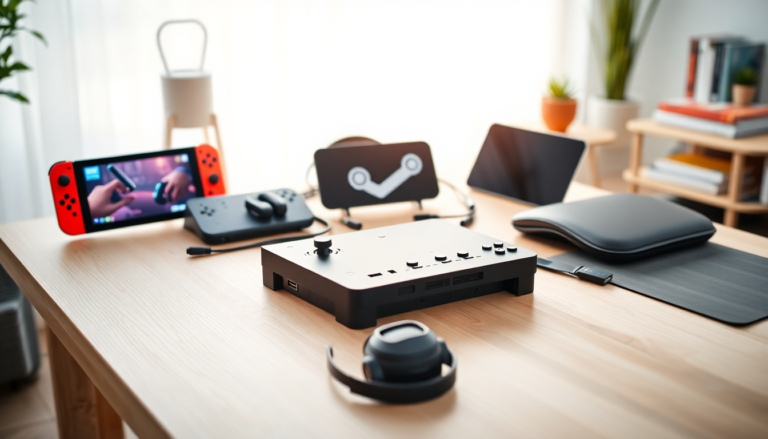Argomenti trattati
As the gaming world evolves, handheld consoles have become essential for gamers craving portability without sacrificing performance. From the iconic Nintendo Switch to the latest releases from Valve and Lenovo, these devices boast a variety of features tailored to different gaming styles. In this guide, we’ll dive into the current market for handheld gaming consoles, highlighting key aspects to consider before making a purchase.
Understanding the Handheld Gaming Market
The landscape of handheld gaming has radically transformed in recent years. Once dominated by basic devices, the arrival of more powerful and versatile consoles has changed how gamers engage with their favorite titles. The Nintendo Switch set a new standard for portable gaming, allowing players to effortlessly transition between handheld and docked modes. Isn’t that the dream for gamers on the go?
Manufacturers are increasingly competing to deliver devices that strike a balance between power, portability, and battery life. The launch of the Steam Deck marked a pivotal moment, pushing other companies to up their game and create handhelds capable of running demanding PC titles. Today, gamers enjoy a rich array of options, each with unique strengths and limitations.
Today’s handheld consoles cater to a broad spectrum of gaming preferences. Whether you’re a die-hard fan of Nintendo’s exclusive titles or you prefer the extensive library available on PC, there’s a handheld device that meets your needs. But with so many choices out there, how do you find the console that’s just right for you?
Key Features to Consider When Choosing a Handheld Console
When you’re in the market for a handheld gaming console, there are several critical factors to consider. Understanding these features can help you make an informed decision that suits your gaming style.
Platform Compatibility
First and foremost, platform compatibility is crucial. Each handheld console operates within its own ecosystem, which means not all games are available on every device. For example, the Nintendo Switch supports titles specifically designed or adapted for its platform, while the Steam Deck utilizes a compatibility layer to run Windows games. Before you pull the trigger on a purchase, take the time to research each console’s game library to ensure it aligns with your gaming interests.
Display Quality
Since handheld gaming often involves extended play sessions, the quality of the display is vital. Many modern devices now feature OLED screens that deliver high resolution and vibrant colors. However, keep in mind that better displays can consume more battery power. Finding the sweet spot between visual quality and battery life is essential for those marathon gaming sessions.
Battery Life and Performance
Battery life can vary significantly across handheld consoles, with some doing a better job of optimizing power consumption than others. Devices like the Nintendo Switch and Steam Deck have made strides in this area, but it’s important to remember that graphics-intensive games can still drain the battery quickly. Consider your gaming habits: will you need additional portable charging solutions, or do you prefer to keep your sessions short and sweet?
A Look at Popular Handheld Consoles
As of 2025, several handheld consoles stand out in the market, each bringing its unique attributes and capabilities to the table.
Nintendo Switch 2
The Nintendo Switch 2 is a notable upgrade from its predecessor, featuring improved load times, enhanced graphics, and backward compatibility with the extensive library of Switch games. Its ability to transition seamlessly between handheld and docked play solidifies its position as a top choice for gamers. Who wouldn’t want that kind of versatility?
Steam Deck OLED
Valve’s Steam Deck has firmly established itself in the handheld gaming market. The OLED version offers superior display quality, a larger battery capacity, and compatibility with a wide range of PC games. Its robust design makes it a formidable choice for gamers looking to tackle AAA titles on the go.
Lenovo Legion Go S
If you’re on the hunt for a Windows-based option, the Lenovo Legion Go S presents a compelling choice. It retains the advantages of running Windows while incorporating features that enhance its usability as a handheld device. The flexibility to switch between operating systems is a significant perk for users seeking options.
Sony PlayStation Portal
While it requires a PS5 for functionality, the PlayStation Portal allows streaming of games directly to its screen, making it an attractive option for dedicated Sony fans. Plus, its lower price point compared to other handhelds makes it a viable choice for those already invested in the PlayStation ecosystem. Isn’t it great to have options?
Conclusion: Choosing the Right Handheld Console
With the plethora of handheld gaming consoles available today, finding the right one ultimately comes down to your personal preferences and gaming habits. Consider platform compatibility, display quality, and battery life as you weigh your options. As technology continues to advance, the handheld gaming experience is only going to improve, making this an exciting time for gamers eager for mobility without compromising on quality.

